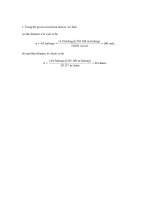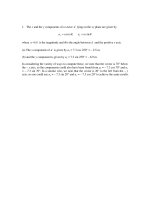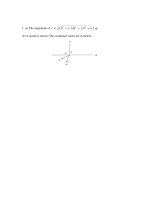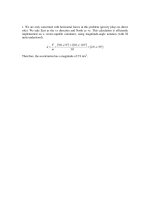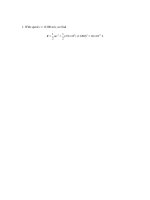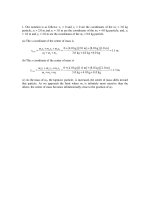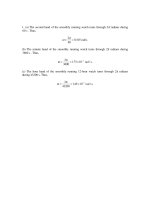Solution manual fundamentals of physics extended, 8th edition ch01
Bạn đang xem bản rút gọn của tài liệu. Xem và tải ngay bản đầy đủ của tài liệu tại đây (556.51 KB, 59 trang )
1. Using the given conversion factors, we find
(a) the distance d in rods to be
d = 4.0 furlongs =
( 4.0 furlongs )( 201.168 m furlong )
5.0292 m rod
= 160 rods,
(b) and that distance in chains to be
d =
( 4.0 furlongs )( 201.168 m furlong )
20.117 m chain
= 40 chains.
2. The conversion factors 1 gry = 1/10 line , 1 line=1/12 inch and 1 point = 1/72 inch
imply that 1 gry = (1/10)(1/12)(72 points) = 0.60 point. Thus, 1 gry2 = (0.60 point)2 =
0.36 point2, which means that 0.50 gry 2 = 0.18 point 2 .
3. The metric prefixes (micro, pico, nano, …) are given for ready reference on the inside
front cover of the textbook (see also Table 1–2).
(a) Since 1 km = 1 × 103 m and 1 m = 1 × 106 µm,
(
)(
)
1km = 103 m = 103 m 106 µ m m = 109 µ m.
The given measurement is 1.0 km (two significant figures), which implies our result
should be written as 1.0 × 109 µm.
(b) We calculate the number of microns in 1 centimeter. Since 1 cm = 10−2 m,
(
)(
)
1cm = 10−2 m = 10 −2 m 106 µ m m = 104 µ m.
We conclude that the fraction of one centimeter equal to 1.0 µm is 1.0 × 10−4.
(c) Since 1 yd = (3 ft)(0.3048 m/ft) = 0.9144 m,
(
)
1.0 yd = ( 0.91m ) 106 µ m m = 9.1 × 105 µ m.
4. (a) Using the conversion factors 1 inch = 2.54 cm exactly and 6 picas = 1 inch, we
obtain
§ 1 inch ·§ 6 picas ·
0.80 cm = ( 0.80 cm ) ¨
¸¨
¸ ≈ 1.9 picas.
© 2.54 cm ¹© 1 inch ¹
(b) With 12 points = 1 pica, we have
§ 1 inch · § 6 picas ·§ 12 points ·
0.80 cm = ( 0.80 cm ) ¨
¸¨
¸¨
¸ ≈ 23 points.
© 2.54 cm ¹ © 1 inch ¹© 1 pica ¹
5. Various geometric formulas are given in Appendix E.
(a) Substituting
c
hc
h
R = 6.37 × 10 6 m 10 −3 km m = 6.37 × 10 3 km
into circumference = 2πR, we obtain 4.00 × 104 km.
(b) The surface area of Earth is
(
A = 4π R 2 = 4π 6.37 × 103 km
)
2
= 5.10 × 108 km 2 .
(c) The volume of Earth is
V=
4π 3 4π
R =
6.37 × 103 km
3
3
(
)
3
= 1.08 × 1012 km3 .
6. We make use of Table 1-6.
(a) We look at the first (“cahiz”) column: 1 fanega is equivalent to what amount of cahiz?
We note from the already completed part of the table that 1 cahiz equals a dozen fanega.
1
Thus, 1 fanega = 12 cahiz, or 8.33 × 10−2 cahiz. Similarly, “1 cahiz = 48 cuartilla” (in the
already completed part) implies that 1 cuartilla =
1
48
cahiz, or 2.08 × 10−2 cahiz.
Continuing in this way, the remaining entries in the first column are 6.94 × 10−3 and
3.47 ×10−3 .
(b) In the second (“fanega”) column, we similarly find 0.250, 8.33 × 10−2, and 4.17 × 10−2
for the last three entries.
(c) In the third (“cuartilla”) column, we obtain 0.333 and 0.167 for the last two entries.
(d) Finally, in the fourth (“almude”) column, we get
1
2
= 0.500 for the last entry.
(e) Since the conversion table indicates that 1 almude is equivalent to 2 medios, our
amount of 7.00 almudes must be equal to 14.0 medios.
(f) Using the value (1 almude = 6.94 × 10−3 cahiz) found in part (a), we conclude that
7.00 almudes is equivalent to 4.86 × 10−2 cahiz.
(g) Since each decimeter is 0.1 meter, then 55.501 cubic decimeters is equal to 0.055501
7.00
7.00
m3 or 55501 cm3. Thus, 7.00 almudes = 12 fanega = 12 (55501 cm3) = 3.24 × 104 cm3.
7. The volume of ice is given by the product of the semicircular surface area and the
thickness. The are of the semicircle is A = πr2/2, where r is the radius. Therefore, the
volume is
V =
π 2
r z
2
where z is the ice thickness. Since there are 103 m in 1 km and 102 cm in 1 m, we have
§ 103 m · § 102 cm ·
5
r = ( 2000 km ) ¨
¸ ¨
¸ = 2000 × 10 cm.
1km
1m
©
¹ ©
¹
In these units, the thickness becomes
§ 10 2 cm ·
2
z = 3000 m = ( 3000 m ) ¨
¸ = 3000 × 10 cm
1m
©
¹
which yields,
V =
π
2000 × 105 cm
2
(
) ( 3000 × 10
2
2
)
cm = 1.9 × 10 22 cm3 .
8. From Figure 1.6, we see that 212 S is equivalent to 258 W and 212 – 32 = 180 S is
equivalent to 216 – 60 = 156 Z. The information allows us to convert S to W or Z.
(a) In units of W,
§ 258 W ·
50.0 S = ( 50.0 S) ¨
¸ = 60.8 W
© 212 S ¹
(b) In units of Z,
§ 156 Z ·
50.0 S = ( 50.0 S) ¨
¸ = 43.3 Z
© 180 S ¹
9. We use the conversion factors found in Appendix D.
1 acre ⋅ ft = (43,560 ft 2 ) ⋅ ft = 43,560 ft 3
Since 2 in. = (1/6) ft, the volume of water that fell during the storm is
V = (26 km 2 )(1/6 ft) = (26 km 2 )(3281ft/km) 2 (1/6 ft) = 4.66 × 107 ft 3 .
Thus,
V =
4.66 × 107 ft 3
= 11
. × 103 acre ⋅ ft.
4
3
4.3560 × 10 ft acre ⋅ ft
10. The metric prefixes (micro (µ), pico, nano, …) are given for ready reference on the
inside front cover of the textbook (also, Table 1–2).
(a)
§ 100 y · § 365 day · § 24 h · § 60 min ·
1 µ century = 10−6 century ¨
¸¨
¸¨
¸¨
¸ = 52.6 min .
© 1 century ¹ © 1 y ¹ © 1 day ¹ © 1 h ¹
(
)
(b) The percent difference is therefore
52.6 min − 50 min
= 4.9%.
52.6 min
11. A week is 7 days, each of which has 24 hours, and an hour is equivalent to 3600
seconds. Thus, two weeks (a fortnight) is 1209600 s. By definition of the micro prefix,
this is roughly 1.21 × 1012 µs.
12. A day is equivalent to 86400 seconds and a meter is equivalent to a million
micrometers, so
b3.7 mgc10 µ m mh = 31. µ m s.
b14 daygb86400 s dayg
6
13. None of the clocks advance by exactly 24 h in a 24-h period but this is not the most
important criterion for judging their quality for measuring time intervals. What is
important is that the clock advance by the same amount in each 24-h period. The clock
reading can then easily be adjusted to give the correct interval. If the clock reading jumps
around from one 24-h period to another, it cannot be corrected since it would impossible
to tell what the correction should be. The following gives the corrections (in seconds) that
must be applied to the reading on each clock for each 24-h period. The entries were
determined by subtracting the clock reading at the end of the interval from the clock
reading at the beginning.
CLOCK
A
B
C
D
E
Sun.
-Mon.
−16
−3
−58
+67
+70
Mon.
-Tues.
−16
+5
−58
+67
+55
Tues.
-Wed.
−15
−10
−58
+67
+2
Wed.
-Thurs.
−17
+5
−58
+67
+20
Thurs.
-Fri.
−15
+6
−58
+67
+10
Fri.
-Sat.
−15
−7
−58
+67
+10
Clocks C and D are both good timekeepers in the sense that each is consistent in its daily
drift (relative to WWF time); thus, C and D are easily made “perfect” with simple and
predictable corrections. The correction for clock C is less than the correction for clock D,
so we judge clock C to be the best and clock D to be the next best. The correction that
must be applied to clock A is in the range from 15 s to 17s. For clock B it is the range
from -5 s to +10 s, for clock E it is in the range from -70 s to -2 s. After C and D, A has
the smallest range of correction, B has the next smallest range, and E has the greatest
range. From best to worst, the ranking of the clocks is C, D, A, B, E.
14. Since a change of longitude equal to 360° corresponds to a 24 hour change, then one
expects to change longitude by 360° / 24 = 15° before resetting one's watch by 1.0 h.
15. (a) Presuming that a French decimal day is equivalent to a regular day, then the ratio
of weeks is simply 10/7 or (to 3 significant figures) 1.43.
(b) In a regular day, there are 86400 seconds, but in the French system described in the
problem, there would be 105 seconds. The ratio is therefore 0.864.
16. We denote the pulsar rotation rate f (for frequency).
f =
1 rotation
1.55780644887275 × 10−3 s
(a) Multiplying f by the time-interval t = 7.00 days (which is equivalent to 604800 s, if
we ignore significant figure considerations for a moment), we obtain the number of
rotations:
§
1 rotation
N =¨
−3
© 1.55780644887275 × 10
·
¸ ( 604800 s ) = 388238218.4
s¹
which should now be rounded to 3.88 × 108 rotations since the time-interval was
specified in the problem to three significant figures.
(b) We note that the problem specifies the exact number of pulsar revolutions (one
million). In this case, our unknown is t, and an equation similar to the one we set up in
part (a) takes the form N = ft, or
§
1 rotation
1 × 106 = ¨
−3
© 1.55780644887275 × 10
·
¸t
s¹
which yields the result t = 1557.80644887275 s (though students who do this calculation
on their calculator might not obtain those last several digits).
(c) Careful reading of the problem shows that the time-uncertainty per revolution is
± 3 × 10 − 17s . We therefore expect that as a result of one million revolutions, the
uncertainty should be ( ± 3 × 10−17 )(1× 106 )= ± 3 × 10− 11 s .
17. The time on any of these clocks is a straight-line function of that on another, with
slopes ≠ 1 and y-intercepts ≠ 0. From the data in the figure we deduce
2
594
tB +
7
7
33
662
tB =
tA −
.
40
5
tC =
These are used in obtaining the following results.
(a) We find
t B′ − t B =
33
( t ′A − t A ) = 495 s
40
when t'A − tA = 600 s.
(b) We obtain
t C′ − t C =
b
g
b g
2
2
495 = 141 s.
t B′ − t B =
7
7
(c) Clock B reads tB = (33/40)(400) − (662/5) ≈ 198 s when clock A reads tA = 400 s.
(d) From tC = 15 = (2/7)tB + (594/7), we get tB ≈ −245 s.
18. The last day of the 20 centuries is longer than the first day by
( 20 century ) ( 0.001 s
century ) = 0.02 s.
The average day during the 20 centuries is (0 + 0.02)/2 = 0.01 s longer than the first day.
Since the increase occurs uniformly, the cumulative effect T is
T = ( average increase in length of a day )( number of days )
§ 0.01 s · § 365.25 day ·
=¨
¸¨
¸ ( 2000 y )
y
© day ¹ ©
¹
= 7305 s
or roughly two hours.
19. We introduce the notion of density:
ρ=
m
V
and convert to SI units: 1 g = 1 × 10−3 kg.
(a) For volume conversion, we find 1 cm3 = (1 × 10−2m)3 = 1 × 10−6m3. Thus, the density
in kg/m3 is
−3
3
§ 1 g · § 10 kg · § cm ·
3
3
1 g cm = ¨ 3 ¸ ¨
¸ ¨ −6 3 ¸ = 1 × 10 kg m .
© cm ¹ © g ¹ © 10 m ¹
3
Thus, the mass of a cubic meter of water is 1000 kg.
(b) We divide the mass of the water by the time taken to drain it. The mass is found from
M = ρV (the product of the volume of water and its density):
(
M = 5700 m 3
) (1 × 10
3
)
kg m3 = 5.70 × 106 kg.
The time is t = (10h)(3600 s/h) = 3.6 × 104 s, so the mass flow rate R is
R=
M 5.70 × 106 kg
=
= 158 kg s.
3.6 × 104 s
t
20. To organize the calculation, we introduce the notion of density:
ρ=
m
.
V
(a) We take the volume of the leaf to be its area A multiplied by its thickness z. With
density ρ = 19.32 g/cm3 and mass m = 27.63 g, the volume of the leaf is found to be
V =
m
ρ
= 1430
.
cm3 .
We convert the volume to SI units:
V = (1.430 cm
3
)
3
§ 1m ·
3
−6
¨
¸ = 1.430 × 10 m .
© 100 cm ¹
Since V = Az with z = 1 × 10-6 m (metric prefixes can be found in Table 1–2), we obtain
A=
1430
.
× 10−6 m3
.
m2 .
= 1430
−6
1 × 10 m
(b) The volume of a cylinder of length " is V = A" where the cross-section area is that of
a circle: A = πr2. Therefore, with r = 2.500 × 10−6 m and V = 1.430 × 10−6 m3, we obtain
A=
V
= 7.284 × 104 m.
2
πr
21. If ME is the mass of Earth, m is the average mass of an atom in Earth, and N is the
number of atoms, then ME = Nm or N = ME/m. We convert mass m to kilograms using
Appendix D (1 u = 1.661 × 10−27 kg). Thus,
ME
5.98 × 1024 kg
N =
=
= 9.0 × 1049 .
−27
m
40 u 1661
.
× 10 kg u
b gc
h
22. (a) We find the volume in cubic centimeters
3
§ 231 in 3 · § 2.54 cm ·
5
3
193 gal = (193 gal ) ¨
¸¨
¸ = 7.31 × 10 cm
© 1 gal ¹ © 1in ¹
and subtract this from 1 × 106 cm3 to obtain 2.69 × 105 cm3. The conversion gal → in3 is
given in Appendix D (immediately below the table of Volume conversions).
(b) The volume found in part (a) is converted (by dividing by (100 cm/m)3) to 0.731 m3,
which corresponds to a mass of
c1000 kg m h c0.731 m h = 731 kg
3
2
using the density given in the problem statement. At a rate of 0.0018 kg/min, this can be
filled in
731kg
= 4.06 × 105 min = 0.77 y
0.0018 kg min
after dividing by the number of minutes in a year (365 days)(24 h/day) (60 min/h).
23. We introduce the notion of density, ρ = m / V , and convert to SI units: 1000 g = 1 kg,
and 100 cm = 1 m.
(a) The density ρ of a sample of iron is therefore
ρ = ( 7.87 g cm
3
)
§ 1 kg · § 100 cm ·
¨
¸¨
¸
© 1000 g ¹ © 1 m ¹
3
which yields ρ = 7870 kg/m3. If we ignore the empty spaces between the close-packed
spheres, then the density of an individual iron atom will be the same as the density of any
iron sample. That is, if M is the mass and V is the volume of an atom, then
V =
M
ρ
=
9.27 × 10−26 kg
= 1.18 × 10−29 m3 .
3
3
7.87 × 10 kg m
(b) We set V = 4πR3/3, where R is the radius of an atom (Appendix E contains several
geometry formulas). Solving for R, we find
13
§ 3V ·
R=¨
¸
© 4π ¹
(
)
13
§ 3 1.18 × 10−29 m3 ·
¸
=¨
¨
¸
4π
©
¹
= 1.41 × 10−10 m.
The center-to-center distance between atoms is twice the radius, or 2.82 × 10−10 m.
24. (a) The volume of the cloud is (3000 m)π(1000 m)2 = 9.4 × 109 m3. Since each cubic
meter of the cloud contains from 50 × 106 to 500 × 106 water drops, then we conclude
that the entire cloud contains from 4.7 × 1018 to 4.7 × 1019 drops. Since the volume of
4
each drop is 3 π(10 × 10-6 m)3 = 4.2 × 10−15 m3, then the total volume of water in a cloud
is from 2 × 103 to 2 ×10 4 m3.
(b) Using the fact that 1 L = 1× 103 cm3 = 1× 10− 3 m3 , the amount of water estimated in
part (a) would fill from 2 × 106 to 2 ×107 bottles.
(c) At 1000 kg for every cubic meter, the mass of water is from two million to twenty
million kilograms. The coincidence in numbers between the results of parts (b) and (c)
of this problem is due to the fact that each liter has a mass of one kilogram when water is
at its normal density (under standard conditions).
25. The first two conversions are easy enough that a formal conversion is not especially
called for, but in the interest of practice makes perfect we go ahead and proceed formally:
(a)
§ 2 peck ·
11 tuffets = (11 tuffets ) ¨
¸ = 22 pecks
© 1 tuffet ¹
(b)
§ 0.50 Imperial bushel ·
11 tuffets = (11 tuffets ) ¨
¸ = 5.5 Imperial bushels
1 tuffet
©
¹
(c)
§
36.3687 L ·
11 tuffets = ( 5.5 Imperial bushel ) ¨
¸ ≈ 200 L
© 1 Imperial bushel ¹
